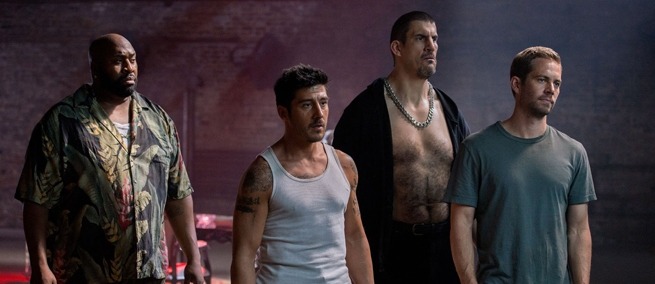
Bidding to be both dystopian science fiction and a breathlessly exciting non-stop action franchise smash, Luc Besson’s newest factory product Brick Mansions is actually neither. The movie’s feints toward genre thoughtfulness are restricted only to imagining that a large section of near-future Detroit has been walled off and written off as a lawless wasteland. Topical perhaps, but hardly a stroke of insight, or much more than a rip from John Carpenter at his pulpiest. In terms of its status as pulse-thundering action experience, which is the facet that most matters to the assemblage of production and distribution entities on hand as well as the film’s ostensible target demo, Brick Mansions performs all the requisite cartwheels but fails in a basic way. It is in fact typical of contemporary “action” moviemaking, and therefore hardly a movie at all, simultaneously overstuffed with physical incident and yet strangely, stultifyingly inert. The thing is supposed to blitz across my eyeballs and nerve-endings like fighter jet, but instead it’s practically motionless, hyperventilating and catatonic.
Would that it were uniquely so, but the truth is, Brick Mansions is only worth discussing insofar as it represents how far modern movies have come from real science fiction, and how far we’ve fallen for the institutional canard of cinematic “action.” Besson’s B-movie—a remake of a French 2004 franchise debut he also produced (District B13)—has as its primary marketing hook the phenomenon of parkour, which coupled with some ersatz martial arts and a few AK-47s comprises the film’s actionful menu of ingredients. Parkour in and of itself is little more than gymnastics performed on and around real buildings, and here we have the form’s diminutive inventor, David Belle, dashing, leaping, climbing and cannonballing down alleys and through windows (always with the aid of a conveniently sturdy rung or pipe). It’s not an unremarkable sight, generally, but as in so many films, we don’t actually get to see it. Besson and first time director Camille Delamarre have shot and/or post-production-modulated every moving sequence with the ubiquitous high-speed shutter-strobe effect, which makes it virtually impossible to focus on what’s happening physically, but is intended as a kind of distractive gesture towards action, giving us the ocular impression of chaotic mayhem when in fact it’s merely Belle climbing a ladder. (I think it was Belle climbing a ladder.) We get confusion when we should be getting clarity.
The effect is only irritating, but the aesthetic reflex, which is pervasive in mainstream movies where the white noise of CGI doesn’t already predominate, is disastrous. It’s a bullshit approximation of action filmmaking, not the real thing, designed to muster reptile-brain excitement when none is earned or honestly cultivated. And it’s everywhere, sanctified by the Bourne sequels and the Fast and Furious franchise, to the extent that a rising generation of global filmgoers will have the reasonable right to believe that cinematic “action”—if it doesn’t involve 100% digital superheroes or giant robots, which is its own brand of misguidance—consists of footage gone jittery on a crank jag, indicating to us thrilling calamity that we in reality have a hard time seeing ourselves.
This shunts aside the inevitability that Brick Mansions uses plenty of CGI—what insurer would allow an eight-figure-budgeted film to catapult its star off roofs for real?— and therefore negates the supposedly-fun veracity of what Belle does with his compact little body. Whatever is going on, it’s not “action.” This is where our current cinema problem lies, if we can go all big-culture for a minute: ”action” is the priority in all movies save rom-coms and austere indies. It has become what our film culture is exclusively about, and filmmakers will use any technological strategy to attain it, even if the end-product is not actually actionful at all. The faked appearance of action, like the feigning of erudition in a presidential debate, is sometimes all that’s deemed necessary.
Movie “action” should be something seen, not suggested to your nervous system, but the larger disconnect here is the misunderstanding of what action is. It’s not storytelling. It is at most punctuation or climactic material, the explosions that raise stakes and give the larger narrative around it emotional weight. Back when Howard Hawks and John Ford were considered “action directors”—hilarious, given the amount of chitchat in their films—the occasional shootout or horse chase or bar brawl only served as pressure spikes in the story being told, and they were used sparingly. As we’ve seen since, if that’s all a movie is, tedium sets in like rigor mortis. But back in the pre-Star Wars era, action scenes were also used sparingly for another reason—action is not only not narrative, it’s storytelling’s antithesis. Like kissing scenes and song interludes, action scenes stop a movie dead in its tracks, and become something we have to wait out so that the narrative can resume. They’re necessary in measured doses, but if they predominate, they become uninvested with meaning, and the movie becomes a series of pointless explosions. (Look at Christopher Nolan’s blockbusters: huge chases/fights, with bits of explanation in between.) At best we have the experience of watching a train speeding by, not the experience of having ridden on the train ourselves.
Certainly, something as peculiar and resonant as a fully explored science fiction idea cannot easily survive in the maelstrom of an “action film,” just as substantial textual stuff can never be crammed into movie trailers. Look at how big-hullabaloo genre franchises, from The Hunger Games to X-Men to Transformers to the new Planet of the Apes reboot, have neglected their starving ideas like bastard children, and swelled up instead with nonstop running, fighting, chasing and shooting. We could hardly be blamed for tapping our feet impatiently, waiting for the distended calisthenics to subside and the real movie to begin.
TOPICS